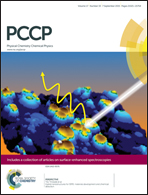Specific ion effects on the hydrophobic interaction of benzene self-assembled monolayers
Abstract
The interaction of aromatic compounds with various ions in aqueous solutions plays a role in a number of fields, as diverse as protein folding and enhanced oil recovery, among others. Therefore, we have investigated the effect of the four electrolytes, KCl, NaCl, MgCl2 and CaCl2, on the hydrophobic interaction of benzene self-assembled monolayers. Using the jump to contact phenomenon of an atomic force microscope (AFM) tip as an indicator of attractive forces between the surfaces of a sample and the tip, we discovered lower frequencies in the snap in as well as narrower distributions for the snap in distance for the monovalent ions, especially for K+, compared with the behaviour for the divalent ions. These observations are explained by the accumulation of charge at the surface by cation–π interactions and an influence of the ions on the formation of capillaries that bridge the tip to the surface. Bridging capillaries, i.e. nanometre scale gas bubbles, are some of the factors contributing to the long range hydrophobic interaction. The results demonstrate how ions influence the attraction of hydrophobic entities in aqueous solutions.



 Please wait while we load your content...
Please wait while we load your content...